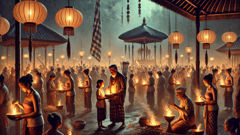Introduction
The story begins at dusk when shadow and incense meet, where the wooden houses of a riverside village lean toward the river as if listening. Smoke from offerings coils into the closing sky; women smooth sarongs and fold their hands around candles while the fields, heavy with rice and the scent of wet earth, prepare for night. The nearest temple bells toll like small ribs of sound through the valley; priests move like quiet birds, palm leaves rustling. It is in this liminal hour, between ritual and rest, that the memory of a queen becomes a living ache—the name Calon Arang carried in whispers from old storytellers to children who hide their faces behind woven fans. She was a woman who had loved and lost, a widow whose grief would not yield to the ordinances of the village. Exiled by suspicion, she turned inward, plaiting sorrow with knowledge older than kings. Those who speak her name say she learned to read the underside of things: the language of steam rising from cooking pots, the voice of frogs in flooded fields, the way vultures pause like punctuation in the dry season. She studied herbs and syllables, the breath behind a prayer and the silence that followed. People described her as a practitioner of magic: some called her a healer, others a witch. Yet the tale that took root among market stalls and temple steps, the tale that carried on the lips of rain-soaked travelers, is not merely about power. It's about the edges of a community, about how exclusion can create a storm no fence can throw back. The king of the land, eager to protect his realm and maintain order, had allies among priests and advisors who feared the upsetting of balance. When crops failed for reasons they could not explain, when children grew pale with fevers that had no known cure, eyes turned toward Calon Arang; not merely in blame but in the urgent, aching need to make sense of suffering. She, in turn, responded in ways that would etch her name deep into the bones of the island's memory. This introduction does not hurry. It invites the reader to walk narrow paths—the muddy lanes between rice paddies and coral reef, to overhear the gossip in a blacksmith's stall, to touch the cracked rim of an offering bowl that once held fragrant flowers and a fate. The story will travel across temples carved with demons and into the private rooms of widows shut away by custom. It will linger in alleys where lamp smoke mixes with the sea breeze and in the flicker of a palm-leaf lamp that, for one night, resists the dark. There are rituals, yes, and the technicalities of chants and sigils, but above all there is the human pulse beneath the myth: the human choices that led to exile, to bitterness, to the use of knowledge as defense and then as weapon. The land itself responds—rain or drought, rat and bird, river and mangrove—so when plague arrives it seems born of both the human and the fragile wild frame that supports the community. This is not a tale of villains and saints who are wholly flat. Instead, you will meet characters who carry contradictions: a queen who heals and harms, a priest who prays and doubts, a daughter who becomes a bridge for reconciliation. The Tale of Calon Arang asks us to consider what happens when grief hardens into wrath, and when those charged with defending a realm resort to force that only deepens the wound. It asks whether order can ever truly be restored without mercy, whether magic—whatever name a culture gives it—can be simply undone by ritual alone. Walk with patience. Listen to the cadence of offerings, to the murmur of the river, and to the small, stubborn hope that even in this story's shadow, some light remains.
The Widow and Her Art
Calon Arang was not born into darkness. Once, before her exile and the final souring of relations with her neighbors, she moved through the world with a grace that combined the measured dignity of nobility and the practical hands of one versed in household rites. Her husband had been a man of standing, a petty king or a nobleman whose courts gathered at twilight to discuss rice quotas and marriages, to bless the harvests and adjudicate petty quarrels. When he died—sudden, or by a slow and secret sickness—Calon Arang was left not only with the heavy inheritance of sorrow but with the sharp, practical knowledge of how a household had been kept together: the medicines, the balance of salt and herb, the ritual sequences that kept misfortune from lodging by the doorstep. She learned more than any neighbor suspected. Widows often keep the old recipes that men ignore: poultices for the quick fevers of children, broths that ease the cough of a laborer come home late. These are small magics, the everyday spells of a living community. But grief shifted something in Calon Arang. It gave her time and solitude, and solitude ripens into concentration. She sought texts and chants kept in the shadow of shrines; she listened to the old women who could remember the time before the current king's grandfather; she taught herself to hear the syntax of ritual. The elders note that she learned the songs that speak to the unseen — the incantations that thread meaning into the spaces between a child's breath and the house's sleeping hush. Trouble began not as violence but as humiliation. A son of another household, perhaps jealous or maybe frightened of the power that sorrow can make, spread a rumor that turned like rot. The men of influence—priests who prefer clean calendars and officials who prefer predictable tax receipts—murmured among themselves. There is a pattern in stories like this: a woman who steps outside expected bounds, who refuses the diminished role offered to a widow, moves quickly from harmless to suspect. Calon Arang was isolated by degrees; she noticed market stalls that no longer called to her, where traders would whisper the coat of her cloak instead of looking her in the face. Children, once given sweets by her palm, were hurried away. She was left with the river, the rice fields, and the language of herbs. How much of what followed was deliberate and how much was reaction is a question the tale toys with. It is simple to cast her, in the telling, as a witch who chose to malign the kingdom. But the detail of those early months matters. The fields that had been generous around the village began to fail in patches, then in tracts. Farmers woke to find young rice blades wilted with a gloss like oil; cows that grazed in the lowland developed pustules or refused to feed; newborns turned a grayish color and slept for days between fits of fever. The obvious explanation among the frightened, the simplest human logic, was that some dishonor had fallen on the place and must be lifted. When people search for a scapegoat, they find the woman who has been pushed outside the circle. Accusation hardened into legal complaint and then into action. Priests, vested with both spiritual authority and social convenience, pronounced that Calon Arang's practices were dangerous and that to permit them was to invite the gods' displeasure. They called for isolation and for exorcisms, for flames to be kindled to burn away impurity. But Calon Arang had learned too much to accept being cut off. She turned the knowledge she had into a defense and, gradually, into a weapon. Her rites, once the mending arts of household survival, took on a different shape. The healer's poultices became components in a larger design; the incantations shifted cadence, quickened, and gathered force. She invoked the same elements the priests said held order—the wind, the rice, the river—then asked them a different question: why should the established order protect those who only perpetuated exclusion? In the nights that followed, strange things began to shape the rumor further. Some said that at low tide she walked the beach and spoke to the sea; others insisted she fed the godlike shadows in the forest with offerings of blood and steamed rice. Scholars and later storytellers would debate whether these images were political theater, moral allegory, or the literal truth. For the villagers trembling between hope and dread, they were indistinguishable: the more they feared what they didn't understand, the more the world rearranged itself to fit their fear. The king, sensing unrest, sent emissaries to demand she stop. Their words were soft and their threats softer still; there is a human weakness to assume that power will prevail because it is power. But when power confronts grief and mastery of certain avian wisdoms—Calon Arang's ability to read omens in the flight of birds, to make the frog's croak answer a petition—the contest becomes not merely political but ontological. An emissary returning from her courtyard told of a woman who answered with a smile that was not devoid of pity; a woman who refused to show submission but did not lash outwardly. The emissary returned with a fever that left him unable to speak for days. Then the story took the shape of a law: to banish her from public rites, to confiscate certain implements, to require a public confession of harmlessness. The banishment, however, carried with it a cruelty: Calon Arang was stripped not only of ceremony but of dignity. She lost the right to enter certain shrines, to be given offerings; she was made an object of ritualized contempt. Once made a symbol of disfavor, she could no longer be a part of the web that once held her household steady, and that separation, in the mind of the narrative, becomes the seed of the larger calamity. There is an old moral in this part of the tale, complicated and bitter: that the social practice of exclusion can produce the very danger it seeks to avoid. Sympathy for Calon Arang does not erase the suffering she later causes; it complicates it, tests the reader's understanding of fault and responsibility. Her magic, at first a domestic art, moved outward. It struck not only at the crops but at the invisible underside of communal life: fertility ceremonies failed, boats returning from the sea were claimed by sudden storms, and those sworn to keep ritual order found their words snagging in their throats. The community, already riven by fear, asked once more for a remedy, but now the remedy would have to look like battle: not only ritual restoration but a confrontation between orders of knowledge—those sanctioned by the king and those that abide in private houses where widows keep the old speech alive. It is here the story opens into an epic: the kingdom will call upon its wisest man, the priests will assemble their texts, and Calon Arang will call upon depth and memory. Men and women who are named later in the tale take on roles that are both archetypal and particular—heroes who are not simple, villains who may be human. Yet the land itself will judge, in the slow, indifferent way of weather and pestilence, and the stakes will be nothing less than the survival of children, the fullness of the rice stores, and the place of mercy in a community that wants above all to be safe.

The Priest, the Scholar, and the Daughter
To confront what had become a swallowing shadow over the kingdom, the court sought help from the men it trusted most: priests who read stars and scholars who knew the old languages. Among them rose a figure remembered in later songs—Mpu Bharada, a sage whose reputation rested on two things: his meticulous knowledge of ritual and an uncanny ability to read undercurrents in the land. Mpu Bharada was not merely a priest but a bridge between oral practice and the more formalized, cosmological texts kept in temple chambers. He had a daughter, Ratna (sometimes called Ratna Mpu in later versions), a young woman who, unlike many daughters of priests, apprenticed in both household medicine and the liturgical chant. Ratna's presence introduces one of the tale's most human threads: a meeting across boundaries that could be parental, political, and spiritual. Stories record that Ratna and Calon Arang never truly hated one another; rather, they occupied different moral frames, a point that makes the eventual confrontation more tragic. Ratna, trained in disciplines sanctioned by the court, had the compassionate curiosity to enter houses where whispers lived, and so she encountered the complexity of Calon Arang—not as a simple fiend, but as a woman whose life had been broken in stages. The king, impatient and fearing revolt of a sort that started not with swords but with hope thwarted and harvests failing, insisted on a decisive remedy. It was Mpu Bharada who proposed a plan that mixes pragmatism with ritual cunning: find a way to undo whatever bond had been formed between Calon Arang and the forces now afflicting the land. The plan required more than brute force. Calon Arang's power was said to be strengthened by her solitude and by offerings made in secret. To break that condition, they would need to restore her to a form of social presence or, failing that, use a counter-knowledge that mirrored hers without resting on cruelty. When Ratna was asked to enter Calon Arang's courtyard under the guise of seeking counsel, she did so with a slow and dangerous empathy. The narrative often pauses here to consider Ratna's motives: is she a spy in service of the king or a young woman with the tender wish to heal a neighbor? Her compassion functions as a narrative device to show the reader how reconciliation might work, even when authorities prefer punishment. In many retellings, Ratna meets Calon Arang as a daughter meets an elder: with questions about grief, about the line between necessary secrecy and dangerous exclusion. Yet Ratna is also the emissary of an order that sees the world in lists, in permissible incantations and formulae. She must learn the vocabulary of both worlds if she is to be of use. The two women's exchange becomes the heart of the moral argument. Calon Arang, still proud and not softened by contrition, tells truths that unsettle: that the village's rituals often exclude women in ways unrecognized by men, that the authority which commands public rites has always been a cage for certain voices. Ratna listens with a mixture of respect and the training she has received that sometimes blinds rather than clarifies. Their dialogue, hidden in the alleys and behind palm screens, sets the scene for a different kind of contest: not only ritual against ritual, but persuasion and knowledge exchanged across a moral rift. Mpu Bharada, for his part, studies the signs and feels the warrants of a world he cannot simply reorder with scripture. He sees sicknesses that trumpet societal failure; he sees weather that will not be calmed by simplistic apology. So he and Ratna decide on a plan that attempts to be precise and merciful: a public ritual that will both expose and contain. Yet secrets complicate the strategy. Calon Arang, having learned a different set of affinities—the way that certain syllables can herd the dark things into shapes, the use of anointing oils mixed with grave herbs—had built a fortress of meaning that could be disturbed only by its own counterpart. Ritual in this tale is not mere ceremony. It is a kind of language in which the words are both oath and tool. The priests speak to deities, but Calon Arang speaks to liminal things: the underside of a palm leaf, the breath between a prayer and its answer. To break her influence required a blending of politics and compassion. The plan, when executed, manifested as a convergence: on one side, the king's forces—men with ordered ranks and torches; on the other, the softer lines of community—women bearing offerings, children singing protective chants, Ratna moving between the two. The conflict is not purely violent; most of it unfolds in the geometry of ritual and the fragile, dangerous negotiation of responsibility. At a certain point, the narrative introduces symbolic figures: the black crow that marks a night when the village's infants sleep deeper than is right; the lotus that sinks in otherwise still waters; the old drum that does not sound on a festival morning. Each symbol registers the breach of harmony. As the public rites begin, the reader is shown the careful choreography of Mpu Bharada's approach—chants arranged in counterpoint to Calon Arang's own strings of voice. The descriptions in the old songs make the air heavy as tamarind smoke; lanterns are set like cautious watchmen around the courtyards. What follows is an exchange of spells and countersinging that in some versions climaxes in a physical confrontation and in others in a kind of negotiated collapse of power. A crucial element is the use of Ratna as a channel. In certain renditions, she embodies reconciliation; her presence allows language to cross from the sanctioned to the forbidden and back again. In others, she becomes a sacrificial figure, a daughter whose mediation comes at a cost. The text is careful to note that she has agency; she does not suffer in silence as some simple martyr. She acts with the awareness of both heartbreak and purpose, willing to risk humiliation and worse to reweave social ties. The turning point in the tale varies depending on the teller's moral appetite. In some accounts, Calon Arang is defeated and the plague ends, the kingdom returns to its rhythms, and the story reads as a tidy victory for the established order. In other, more complicated tellings, the resolution involves acknowledgment, restitution, and the reluctant admission by authorities that their approach to people like Calon Arang was part of the sickness. These more reflective versions suggest that the wounds cannot be healed by punishment alone. They require the recognition of human loss and the reintegration of those pushed out. The Tale of Calon Arang thus refuses an uncomplicated moral. It lets us see the human cost of exclusion, the seduction of absolute authority, and the small, brave acts that hold out for mercy. The priest and the scholar are necessary but not sufficient; the daughter's courage and the widow's complicated strength are what move the narrative toward a resolution that may be bitter, may be partial, and yet remains profoundly instructive. When the plague lifts—if it does—there remains a trace in the songs of the island: a memory of loss, a lesson about the limits of power, and a cautionary note about the ways that societies decide who belongs.

Conclusion
When the tale closes, it leaves room for ambiguity. Some say Calon Arang was undone by her own fury, that bitterness curdled into a force she could no longer steer. Others insist she was never the true source of the devastation but rather its mirror—a woman shaped by a community's refusal to recognize her grief and her knowledge. The last scene in many tellings is not a triumphal march of the king back into unquestioned authority, but a quieter image: ashes on an offering plate, a child's recovered laugh, a priest who looks at his own hands and wonders what he has done. The island keeps these images in song because the story addresses things communities rarely like to put into law: the cost of exclusion, the danger of simple answers, and the complex geography of blame. The moral is not a single, sharp point but a set of textures. Above all, The Tale of Calon Arang insists that power is never a clean thing. It can protect and it can wound; it can bind and it can blind. When a society reacts to fear by seeking a single culprit, it might miss the slow unspooling of a wound that begins much earlier in the way people treat one another. Healing, then, is not only the performance of correct rites. It is also the mundane, difficult work of reintegration: the asking of forgiveness, the willingness to restore what was taken, the care given to those still trembling at the edges. The legend endures because it speaks to perennial human anxieties: how to grieve without harming others, how to govern without stifling the margins where vital knowledge often hides, and how to balance justice with mercy. As soon as the story is told, children pick up its cadences, priests sketch its outlines into instruction, and elders fold its lessons into the small rituals that keep communities whole. The name Calon Arang remains a tool of both caution and memory: a caution against letting grief become fury that consumes the common good, and a memory of the obligations to welcome back those we have cast out. In the end, whether you leave the tale as a dark parable about the power of the excluded or read it as a plea for humility among the powerful, it asks this of us: to listen when someone at the village edge speaks, to measure our condemnations with an awareness of what we have stripped from them, and to see that sometimes the true remedy for plague and ruin begins with the simplest, hardest act—the act of returning a neighbor to the circle of common care.













